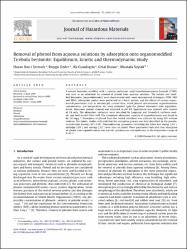Removal of phenol from aqueous solution by adsorption onto organomodified Tirebolu Bentonite: Equilibrium, kinetic and thermodynamic study
Erişim
info:eu-repo/semantics/openAccessTarih
2009Erişim
info:eu-repo/semantics/openAccessÜst veri
Tüm öğe kaydını gösterKünye
H.B. Şenturk, D. Ozdes, A. Gündoğdu, C. Duran, M. Soylak, “Removal of phenol from aqueous solution by adsorption onto organomodified Tirebolu Bentonite: Equilibrium, kinetic and thermodynamic study”, Journal of Hazardous Materials, 172, 353-362 (2009).Özet
A natural bentonite modified with a cationic surfactant, cetyl trimethylammonium bromide (CTAB), was used as an adsorbent for removal of phenol from aqueous solutions. The natural and modified bentonites (organobentonite) were characterized with some instrumental techniques (FTIR, XRD and SEM). Adsorption studies were performed in a batch system, and the effects of various experimental parameters such as solution pH, contact time, initial phenol concentration, organobentonite concentration, and temperature, etc. were evaluated upon the phenol adsorption onto organobentonite. Maximum phenol removal was observed at pH 9.0. Equilibrium was attained after contact of 1 h only. The adsorption isotherms were described by Langmuir and Freundlich isotherm models, and both model fitted well. The monolayer adsorption capacity of organobentonite was found to be 333 mg g-1. Desorption of phenol from the loaded adsorbent was achieved by using 20% acetone solution. The kinetic studies indicated that the adsorption process was best described by the pseudo-second-order kinetics (R2 > 0.99). Thermodynamic parameters including the Gibbs free energy (?G°), enthalpy (?H°), and entropy (?S°) were also calculated. These parameters indicated that adsorption of phenol onto organobentonite was feasible, spontaneous and exothermic in the temperature range of 0-40 °C.


















